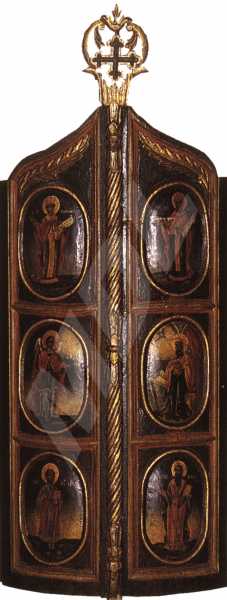Diakonikon Altar Gates
Type:
Plastic iconographical object:
Altar doors
Period:
The middle of the
19 century
Velyan Hristov Ognev (Usta Velyan) -
Born in 1795 in the village of Lazaropole, District of Debar. In 1835 he had been invited to decorate the "Holy Trinity" church in Bansko and had thus become a permanent resident of that town. He had made the decorations in the church's naos, painting the pillars of the iconostasis, the pillars supporting the vault and the surface above the arches, as well as the walls around the windows. Today the walls of the church are covered with later frescoes (1957) and the decorative frescoes of Velyan Ognev had thus been done away with. On the wooden surfaces in the church's naos he had painted garlands of flowers, floral and geometric motifs, etc. His works have a nice colouring and prove the painter's skill in arranging the motifs of floral elements. He had soon become famous throughout the region and had begun to decorate the houses of well-to-do Banskovites. Instead of a part of the pay for his work in the church, the trustees had given him a building plot, on which he had constructed his house. It is difficult to see the house's decorated with frescoes walls, because the courtyard is surrounded by a high wall. In 1877 he had decorated the drawing-room with frescoes of landscapes, views of cities, of sea ports, against the background of a seascape with high-masted boats. In one of the landscapes Velyan Ognev had painted himself on horseback. There is above the landscapes a wide frieze of intricately combined floral elements and ornaments. Inscribed above the fireplace is the year 1877, most probably by one of his heirs. This house is today declared a monument of culture. He had also been working in the house of kir Nikola, decorating it with frescoes and woodcarvings. Works of his are to be found in Salonika and in Serres. He used to work with a big team of helpmates and had a special group to make wooden wedding chests, on which he used to paint a rich decoration. Included in the group of helpmates had also been his son Angel Velyanov. He had died after 1847 in Bansko.
Dimiter T. Molerov, born in 1780 in Bansko, son of Toma Vishanov the Moler. One of the best-known painters, a representative of the Bansko school of art, a disciple of his father, influenced by the art of Athos. Author of the murals of the naos in the St Archangels' paraclete in the Rila monastery, the murals in the Church of the Assumption of the Virgin in the Pchelino dependance. In 1840 and 1841 together with his son Simeon Molerov he paints the murals and the sponsors' portraits in St. Nicholas' and St. John of Rila's paracletes in the principal church in the Rila monastery. Among D. Molerov's major achievements in iconography are the following icons: St. Nicholas (1816) from St. Archangel Michael's church in the village of Leshko, Christ All-triumphant with Angels and Cherubim (1833), The Nativity and a Crucifixion from St Elijah the Prophet's church in the village of Usenovo. He has also worked in Belgrade on an invitation by Prince Milosh Obrenovich of Serbia. He died in 1870 in Bansko.
Dimmensions (cm):
200
/ 78
/ 4
Location
Country: Bulgaria
Province: Blagoevgrad
Town: Bansko
Church: St. Trinity
Other location: From the iconostasis
Source
Country: Bulgaria
Province: Blagoevgrad
Town: Bansko
Church: St. Trinity
Other source: From the iconostasis
Object identification notes
Velyan Ognev (?)
The graphic line-work and the colouring betray the hand most probably of Dimiter Molerov.
Description
Portrayed on the two wings of the Diakonikon Gates, in elliptic medallions, are the figures of: on the left wing - the prophet Solomon, Archangel Gabriel, Saint John Chrysostom; on the right wing - the prophet David, the Holy Mother of God, and Saint Basil the Great.
Iconographical technique: Tempera
A low-relief wood-carving with gilding
Base material: Wood
State, restoration traces and comments
There are no traces of any previous restorative intervention.


